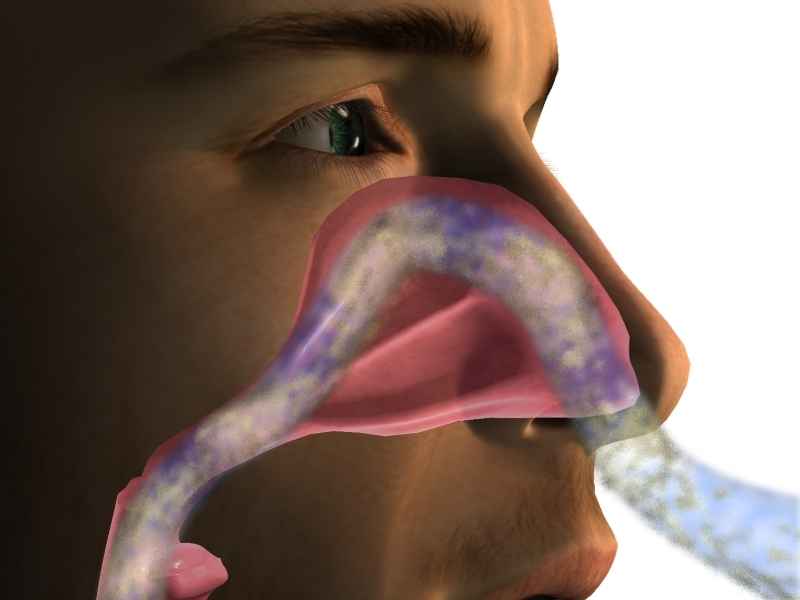The Ultimate Biohack: Nose Breathing

Nose breathing is something that humans are designed to do by default, but up to 50% of the human population engages in mouth breathing instead, at least to some degree. In fact, most people are only using about 10-20% of their lung capacity! Not only are you made for nose breathing, it offers countless benefits, and can positively affect all the activities you do across all areas of your life. You can increase productivity at work for example, enhance sports performance, improve your sleep, help you experience deeper focus, and so much more.
Nose breathing and its benefits
Nose breathing is just what it sounds like: you breathe through the nose instead of the mouth. You often don’t think about your breathing, since it is an automated process. However, consciously breathing through your nose is the optimal way to breathe.
When you breathe in through your nasal cavity, the air goes through three main chambers of the upper body. As air enters the nose, it enters the nasal cavity. Tiny hairs called cilia begin to filter out allergens, dust - even viruses. In fact, those cilia in your nose can filter tens of billions of foreign particles in one day! Next, the air moves to the windpipe where mucus further traps any unwanted particles. Finally, the air makes its way to your lungs where it is able to enter the bloodstream. This entire process also humidifies the air, warms it to body temperature, and purifies it.
Other physical benefits result from nose breathing. It slows down your breathing rate. Slower breathing equates to a more calm state of mind. This, in turn, lowers the heart rate and blood pressure, as well as helps decrease cortisol (stress hormones) in the body, among other benefits.
Mouth breathing has the opposite effect. You tend to breathe more shallowly and rapidly when you breathe through the mouth, which can make you feel more stressed. Think about the well-known fight or flight response: you have rapid, shallow breathing to prepare for possible flight. You’re not exactly sending the signal to “relax” if you’re breathing like this.
Why even have mouth breathing? Well, the mouth lets you eat, drink, talk, and if your nose is clogged, you can still breathe. It does have a purpose.

Mouth breathing disrupts the sleep cycle
How many of you snore or know someone who does? There is a high probability that you, or someone you know, is breathing through the mouth during the night. Mouth breathing contributes to snoring, and can progress to sleep apnea.
Decades of studies demonstrate that mouth breathing negatively impacts the sleep cycle. Having your mouth open at night positions your head so that your airway is partially obstructed. At best, snoring is the result. At worst, your tonsils and adenoids can swell up from irritation, causing you to stop breathing at times during the night (sleep apnea).
Nose breathing and dental health
In nose breathing, your mouth is closed, of course. But when you breathe through your mouth, it’s open. A mouth that's open for extended periods of time can adversely affect your teeth and gums.
A closed mouth helps maintain a moist environment which contributes to better gum health and fresher breath. An open mouth dries out the tissues. Dry tissues lead to a more acidic environment. These conditions promote tooth decay. A dry mouth can also compromise gum health and cause bad breath. This is because the mouth is dark and just moist enough (even though it feels dry) to allow bacteria to proliferate.
Even more disturbing, too much mouth breathing can lead to malformation of the jaw, crowded teeth, and a deep palate at the top of the mouth. This is because you have to make physical adjustments in the way you breathe.
A study done on rhesus monkeys demonstrated how the face can take on an elongated shape in mouth breathers. Researchers inserted nasal plugs into their noses to force them to breathe through the mouth. Their faces got demonstrably longer over time.
Why is that? When the mouth is closed, the tongue is in an anatomically correct position. The jaw and surrounding muscles can develop normally and also maintain a normal position. The teeth are free to develop without too much crowding. None of this can happen with mouth breathing. The roof of the mouth almost has to extend upward to make room for more oxygen intake, pulling the gums and teeth along with it.

Oxygen intake with nasal breathing
When you engage in nasal breathing only, your oxygen (O2) intake is anywhere from 10-20% greater than with mouth breathing. This is due, in part, to the higher-quality air that nose breathing provides. You’re getting that nice, filtered air. You also have more “resistance” when you breathe through the nostrils. Of course, the nostril openings are smaller than breathing through the mouth. It is that resistance that prompts you to take in more air. This greater air volume then expands into the lower lungs. Greater amounts of O2 going into the lungs mean that you get more O2 into the blood by default. More O2 is good for the body - you feel more awake, your energy increases, bodily processes work more efficiently, your brain is happier, and the list goes on.
In addition, always engaging in nose breathing – no matter the activity – makes your lungs more efficient at extracting oxygen from the air. Furthermore, you’ll have leftover O2 from your inhalation, meaning that your body can still extract oxygen even as you are exhaling. This creates a better balance of O2 to carbon dioxide (CO2) in the blood, which leads to a pH-balancing effect.
Something very different happens with mouth breathing. You end up breathing too much. You think, “I’m breathing more; I’m getting more air.” Actually, you’re not. Air moves into the top of the lungs but doesn’t have a chance to expand into the lower lungs. According to Patric McKeown, a breathing therapist, when you’re doing more rapid breathing (such as with mouth breathing), your lungs are only about 50% efficient at getting O2 into the bloodstream. But if you slow down and expand your breathing – which automatically happens when you do nose breathing - that rate jumps. 12 breaths per minute yields about 70% efficiency and goes even higher when you take less breaths per minute. The optimal rate? About 6 breaths per minute.
Not surprisingly, mouth breathers have lower O2 concentrations in the blood. If the lungs aren’t as efficient at extracting O2, less of it will be circulating around the body. The body has to work harder as a result, which not only means you'll have less O2 nourishing your organs, over time, that can lead to higher blood pressure, and other possible health issues.
Nitric oxide with nostril breathing
Did you know that your parasinus area produces nitric oxide (NO)? You might know NO as “laughing gas.” Chuckles aside, the body needs it in small amounts to open up the bronchial tubes in the lungs. It’s also a vasodilator, meaning that it opens up the blood vessels as well. Still, it helps maximize efficiency with the O2 and CO2 exchange in the lungs. The body uses NO across body systems to optimize gas exchange, maintain muscle efficiency, and help get O2 where it needs to go.
There are other benefits to allowing your sinuses to infuse the air you breathe with NO. Studies suggest that it might help reduce exposure to viruses and bacteria as well as help to keep them from replicating in the first place. This is in addition to the natural filtering that happens in the nose and windpipe. Nose breathers might have lower incidents of viral illness, including contracting the common cold, and even SARS-CoV-2 (COVID-19)!

Nose breathing and athletic performance
Nasal breathing can help your workout! Of course, it’s not always easy to breathe through the nose when you feel deprived of oxygen and you’re breathing hard. Many people do switch to mouth-breathing just to help themselves get more air.
Part of this is due to the resistance you feel when you’re breathing hard through the nostrils. Initially, you do get more O2 with mouth breathing because that’s exactly what the body is trying to do: get more oxygen now. The heart is beating faster, your muscles need more O2 to keep functioning. Mouth breathing becomes a way to get higher levels of O2 into the body immediately.
However, given all the facts and data above, you already know that the air you breathe in will be cooler (you've probably experienced a burning sensation when you breathe in cool air through the mouth), you're not extracting O2 as efficiently, your breathing is more rapid and shallow, and air won’t get into the lower lungs nearly as well.
This is where many athletes can really take their performance to the next level: they can train themselves to always nostril breathe. They exert less effort overall with nose breathing and can breathe less. However, to sustain nose breathing over time requires adapting and training the body to do it.
Athletes who train to only nostril breathe, breathe out more CO2 because the body is able to extract more oxygen upon inhalation, leaving more CO2 for exhalation. They have slower breathing rates, which is advantageous because the body doesn’t have to work the breathing muscles as hard. It becomes much more efficient at exchanging O2 and CO2. In addition, the level of O2 they can extract from the air matches the amount they can get from mouth breathing over time. It takes about six to eight weeks for the lungs to adapt to nose-only breathing while under hard exertion, such as exercise.
Ways to get better at nose breathing
- First, practice, practice, practice. When you’re going about your day, consciously keep your mouth closed and inhale through the nose normally. When you work out, continue exercising until you feel that you need to breathe through your mouth. Instead of breathing through the mouth, however, back off in exercise intensity until your breathing resumes a more normal rhythm. That way, you can continue to breathe through the nose. Resume your exercise until you need to back off again. Eventually, the body will adapt, but it will take some months before you’re fully able to exercise without backing off.
- Second, practice belly breathing - all the time - while breathing only through the nose. Essentially, this is breathing into the diaphragm. If you don’t know how to do that, place your hand on your stomach or belly button. When you breathe in, you want your hand to move out in tandem with your belly, while the chest remains still. This helps teach your body to use more lung capacity and naturally increase O2 consumption through the nostrils.
- Check your posture. If you’re sitting at a computer slumped over, for example, it’s going to be hard to nose-breathe effectively. Sit or stand with your back straight and feet flat on the floor to help you breathe more efficiently.
- You can try nasal strips to help open your nostrils. These can be especially effective at night to help alleviate snoring.
- Another way to help you consciously move into more nose breathing is to practice alternate nostril breathing. Page 4 of our guide, “How to Live Stress-Free in a Stress-filled World” explains in detail how to do this.
- We published an article on “Breathing exercises that are really good for you.” All of these exercises will help you learn to breathe more effectively, too.
- Nasal irrigation is good way to clear out your nasal passages, especially if it’s difficult to breathe solely through the nose. You can use a neti pot or similar device to achieve this. However, if you have trouble breathing through your nose in general, it’s a good idea to see a specialist to help diagnose what might be going on.

Incorporating nose breathing with HUSO
Why talk about nose breathing when our specialty is sound healing? Well, the breath is life. No human can exist without it. Ancient civilizations understood the power of the breath, even as we understand it better and better today. It can also be used as part of a mindfulness practice. It can be used to heal.
Sound healing is a powerful practice. It, too, is a mindful practice. It creates coherence in your body. It promotes focus, better sleep, and relaxation – especially with human sound. Sound healing in tandem with conscious breathing can create an incredible platform for you to reach your greatest potential.
HUSO is known for helping you to comprehensively relax. When you pair that with the slow, rhythmic motion of a nasal breath, it’s that much more powerful. The natural, slow rhythm of nose breathing complements the rhythms and frequencies of the HUSO programs. The deep tones and sounds of the lossless music, combined with the healing frequencies delivered through the HUSO pads help you to deeply relax and destress. Pair that up with the feel-good hormones your body releases as a result of slow breathing, and you can imagine the wonderfully powerful and relaxing effect of these two practices.
Finally, you can use intention to achieve exactly what you set out to do. If, for example, you want to increase FOCUS, you can listen to that program while engaging in nose breathing, and then continue to nose breathe throughout the day to maintain higher levels of O2 in the body, thereby automatically increasing your focus and attention.
When you put the benefits of HUSO together with nasal breathing, you just might become unstoppable!
What are you waiting for? Are you breathing just through your nose yet?

